
The University of Notre Dame du Lac, known simply as Notre Dame or ND, is a private Catholic research university in Notre Dame, Indiana, outside the city of South Bend. French priest Edward Sorin founded the school in 1842. The main campus covers 1,261 acres in a suburban setting and contains landmarks such as the Golden Dome, the Word of Life mural, Notre Dame Stadium, and the Basilica. Originally for men, the university did not formally accept undergraduate female students until 1972.
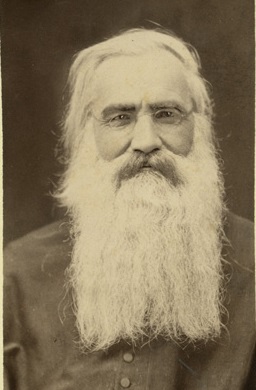
Rev. Edward Frederick Sorin, C.S.C. was a French-born priest of the Congregation of Holy Cross and the founder of the University of Notre Dame in Indiana and of St. Edward's University in Austin, Texas.

The Basilica of the Sacred Heart in Notre Dame, Indiana, is a Catholic church on the campus of the University of Notre Dame, also serving as the mother church of the Congregation of Holy Cross (C.S.C.) in the United States. The neo-gothic church has 44 large stained glass windows and murals completed over a 17-year period by the Vatican painter Luigi Gregori. The basilica bell tower is 230 feet (70 m) high, making it the tallest university chapel in America. It is a contributing building in Notre Dame's historic district listed on the National Register of Historic Places. The basilica is a major tourist attraction in Northern Indiana, and is visited annually by more than 100,000 tourists.

The Rev. William Corby, CSC was an American priest of the Congregation of Holy Cross, and a Union Army chaplain in the American Civil War attached to the Irish Brigade. He served twice as president of the University of Notre Dame.

St. Edward's Hall is one of the 32 Residence Halls on the campus of the University of Notre Dame and one of sixteen male dormitories. Saint Edward's Hall is located directly east of the Main Administration Building and is directly west of Zahm Hall and houses 162 undergraduate students. The structure, the oldest among all residence halls on campus, was built in 1882 to house the minims, Notre Dame's boarding school program. When such program was discontinued in 1929, the building was converted to an undergraduate residence hall, which it has been ever since. Together with other historical structures of the university, it is on the National Register of Historic Places. The coat of arms is the Cross of Saint Edward the Confessor on a green background.

Sorin Hall, also known as Sorin College, is the oldest of the 32 Residence Halls on the campus of the University of Notre Dame and one of the 16 male dorms. It is named after Edward Sorin, the founder of Notre Dame. Sorin is located directly north of Walsh Hall and is directly south of the Basilica of the Sacred Heart. Sorin houses 143 undergraduate students. Sorin Hall is, along with other building on the Main Quad of Notre Dame, on the National Register of Historic Places. Sorin Hall was the first Notre Dame residential hall established as such, although St. Edward's Hall is housed in an older building.
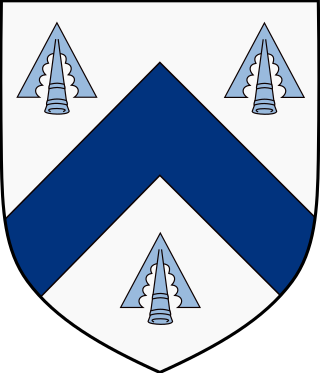
Walsh Hall is one of the 32 Residence Halls on the campus of the University of Notre Dame. Walsh is located on Main ("God") Quad, directly south of Sorin Hall and is directly north of the Knights of Columbus Building. It was built in 1909 and the architect was William J. Brinkmann. Among other buildings on the Main Quad of Notre Dame, Walsh Hall is on the National Register of Historic Places. The coat of arms is taken from the Walsh family.
The Laetare Medal is an annual award given by the University of Notre Dame in recognition of outstanding service to the Catholic Church and society. The award is given to an American Catholic or group of Catholics "whose genius has ennobled the arts and sciences, illustrated the ideals of the church and enriched the heritage of humanity." First awarded in 1883, it is the oldest and most prestigious award for American Catholics.
There are currently 33 undergraduate residence halls at the University of Notre Dame, including 32 active residence halls and Zahm Hall, which serves as a transition dorm when residence halls undergo construction. Several of the halls are historic buildings which are listed on the National Register of Historic Places. Each residence hall is single-sex, with 17 all-male residence halls and 15 all-female residence halls. Notre Dame residence halls feature a mixed residential college and house system, where residence halls are the center of the student life and some academic teaching; most students stay at the same hall for most of their undergraduate studies. Each hall has its own traditions, events, mascot, sports teams, shield, motto, and dorm pride. The university also hosts Old College, an undergraduate residence for students preparing for the priesthood.
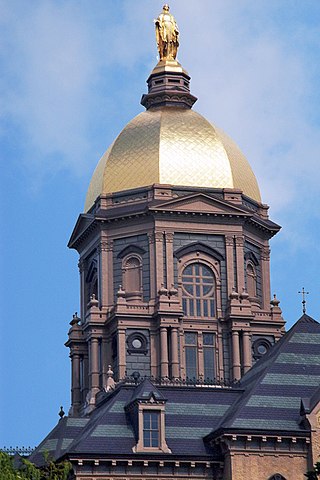
University of Notre Dame's Main Administration Building houses various administrative offices, including the office of the President. Atop of the building stands the Golden Dome, the most recognizable landmark of the university. Three buildings were built at the site; the first was built in 1843 and replaced with a larger one in 1865, which burned down in 1879, after which the third and current building was erected. The building hosts the administrative offices of the university, as well as classrooms, art collections, and exhibition spaces. The building is listed on the National Register of Historic Places.

Theodore Hesburgh Library is the primary building of the University of Notre Dame's library system. The present-day building opened on September 18, 1963, as Memorial Library. In 1987, it was renamed Hesburgh Library, in honor of Rev. Theodore Hesburgh, C.S.C., who served as the university's president from 1952 to 1987. The library's exterior façade that faces the university's football stadium includes a large, 134-foot (41 m) by 68-foot (21 m) mural called The Word of Life, or more commonly known as Touchdown Jesus. As of 2009, the library ranked as the 61st largest collection among research universities in the United States, with an estimated 3.39 million volumes.

The University of Notre Dame was founded on November 26, 1842, by Father Edward Sorin, CSC, who was also its first president, as an all-male institution on land donated by the Bishop of Vincennes. Today, many Holy Cross priests continue to work for the university, including as its president. Notre Dame rose to national prominence in the early 1900s for its Fighting Irish football team, especially under the guidance of the legendary coach Knute Rockne. Major improvements to the university occurred during the administration of Rev. Theodore Hesburgh between 1952 and 1987 as Hesburgh's administration greatly increased the university's resources, academic programs, and reputation and first enrolled women undergraduates in 1972.

Luigi Gregori (1819–1896) was an Italian artist who worked at the Vatican and served as artist in residence and professor at the University of Notre Dame.

The Grotto of Our Lady of Lourdes is located at the University of Notre Dame in Notre Dame, Indiana, United States, and is a reproduction of the Grotto of Our Lady of Lourdes in Lourdes, France. The current Grotto was built in 1896, replacing a wooden grotto built on August 22, 1878. An artificial rock cave, the Grotto is used by its visitors as a sacred space for prayer, meditation, and outdoor Mass.
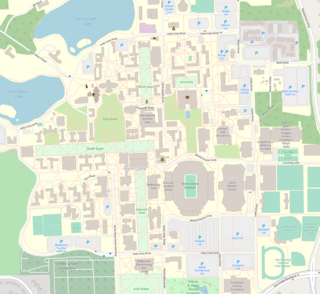
The campus of the University of Notre Dame is located in Notre Dame, Indiana, and spans 1,250 acres comprising around 170 buildings. The campus is consistently ranked and admired as one of the most beautiful university campuses in the United States and around the world, particularly noted for the Golden Dome, the Basilica and its stained glass windows, the quads and the greenery, the Grotto, Touchdown Jesus, its collegiate gothic architecture, and its statues and museums. Notre Dame is a major tourist attraction in northern Indiana; in the 2015–2016 academic year, more than 1.8 million visitors, almost half of whom were from outside of St. Joseph County, visited the campus.
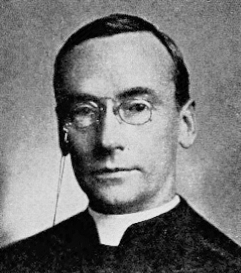
The Rev. James Aloysius Burns, C.S.C. was an American priest and President of the University of Notre Dame from 1919 to 1922. He was crucial in transforming Notre Dame into a national research university. He was professor of chemistry at Notre Dame from 1895 to 1900. He was a theorist of education, and wrote numerous books on the topic.
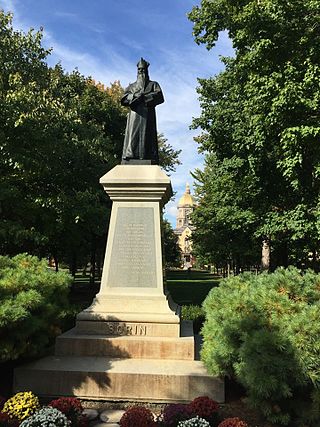
Edward F. Sorin is an outdoor sculpture by Italian sculptor Ernesto Biondi. It is located on the campus of the University of Notre Dame near South Bend, Indiana. The eight foot tall statue depicting the founder of Notre Dame is placed on the main quadrangle of the University near the Main Building. The statue, made of bronze, was unveiled on its campus on May 3, 1906.
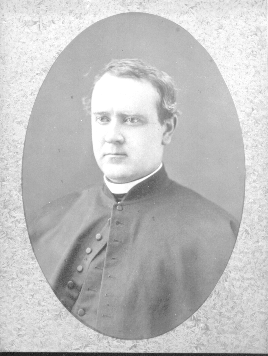
The Rev. Patrick J. Colovin, C.S.C. was an Irish-Canadian Catholic priest, and fifth President of the University of Notre Dame from 1874 to 1877.
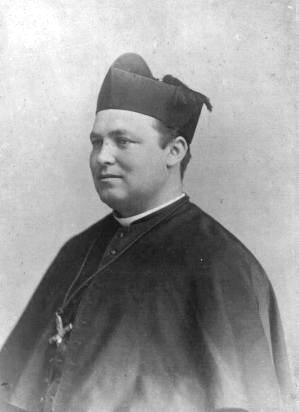
The Rev. Thomas E. Walsh, C.S.C. was an Irish-Canadian Catholic priest, and seventh President of the University of Notre Dame from 1881 to 1893. He was born one of nine in Lacolle, Quebec, son of Thomas Walsh and Winifred McDermott. He was educated at the College de Saint-Laurent, where he caught the attention of Rev. Edward Sorin, who saw his potential. He finished his studies there in 1872 and entered the Novitiate. Sorin sent him to study at College de Ste. Croix in Neuilly, close to Paris, where he spent three years. He was recalled to Notre Dame in 1876 in order to improve enrollment. He was ordained a priest on August 29th, 1877 by Bishop Joseph Dwenger of Fort Wayne and then assumed the role of Dean of Students. After the great fire of 1879, Walsh was in charge of rescheduling classes and professors in the newly reopened college, and his administrative ability led Sorin and William Corby to pick him as next president in 1881. He died of kidney disease at the age of 40.

The coat of arms of the University of Notre Dame is the assumed heraldic achievement of the University of Notre Dame. It was designed by noted American heraldrist Pierre de Chaignon la Rose in 1931.
































